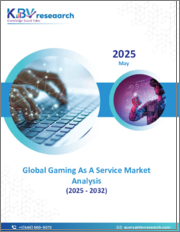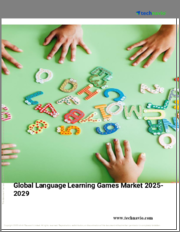
|
시장보고서
상품코드
1865247
교육 게임 시장 규모, 점유율, 성장 분석 : 연령층별, 학습 목표별, 대상자별, 지역별 - 업계 예측(2025-2032년)Educational Games Market Size, Share, and Growth Analysis, By Age Group (Preschool, Primary School ), By Learning Objectives, By Target Audience, By Region - Industry Forecast 2025-2032 |
||||||
세계의 교육 게임 시장 규모는 2023년에 48억 달러로 평가되며, 2024년 53억 2,000만 달러에서 2032년까지 121억 8,000만 달러로 성장할 전망입니다. 예측 기간(2025-2032년)의 CAGR은 10.9%로 예측됩니다.
디지털 학습으로의 전환을 배경으로 세계 교육용 게임 시장은 괄목할 만한 성장을 거듭하고 있습니다. 학교나 연수원을 포함한 교육기관에서는 기존의 교육 방식을 강화하기 위해 게이미피케이션를 활용한 툴의 도입이 확대되고 있습니다. 이를 통해 학생들의 학습의욕, 비판적 사고력, 지식 정착률 향상을 목표로 하고 있습니다. 이 게임들은 스토리텔링과 인터랙티브한 과제를 활용하여 학습을 재미있고 효과적으로 만들어 줍니다. 교육 기관은 게임 기반 플랫폼에 많은 투자를 하고 있으며, 개발자들은 맞춤형 적응형 교육 솔루션을 제공하기 위해 혁신을 거듭하고 있습니다. 또한 스마트폰 및 태블릿의 보급과 저렴한 인터넷 접속이 결합되어 교실을 넘어선 학습을 촉진하고 있습니다. 학부모들도 가정학습을 위해 게이미피케이션 앱을 활용하여 지속적인 참여를 유도하고 있습니다. 이러한 교육기관 수요와 모바일 보급의 융합은 전 세계에서 게이미피케이션 분야의 확장을 촉진하고 있습니다.
세계 교육용 게임 시장 성장 촉진요인
세계 교육용 게임 시장의 주요 시장 성장 촉진요인 중 하나는 학생들의 참여를 높이고 교육 성과를 향상시키는 혁신적인 학습 솔루션에 대한 수요 증가입니다. 교실내 디지털 기술의 확산과 교육 방법으로서의 게이미피케이션의 수용 확대는 기존의 학습 방식을 변화시키고 있습니다. 교육용 게임은 학습을 재미있고 인터랙티브하게 만들 뿐만 아니라, 다양한 학습 스타일에 대응하여 개별화된 교육 경험을 제공합니다. 또한 모바일 단말기와 인터넷의 보급으로 광범위한 도입이 가능해져 학생들이 자신의 페이스에 맞추어 학습할 수 있는 환경이 조성되고 있습니다. 이는 교육용 게임 분야의 성장을 가속하고 있습니다.
세계 교육용 게임 시장 성장 억제요인
세계 교육용 게임 시장의 주요 시장 성장 억제요인은 특히 개발도상국 및 농촌 지역의 기술 접근성 제한입니다. 학교와 학생을 포함한 많은 잠재적 사용자들은 디지털 교육용 게임에 효과적으로 참여하기 위해 필요한 기기나 안정적인 인터넷 연결이 부족합니다. 이러한 디지털 격차는 교육용 게임 솔루션의 도입과 통합을 방해하고 궁극적으로 시장 성장을 제한합니다. 또한 교육자와 학생들 간의 기술 문해력 수준이 다르다는 점도 학습 환경에서 이러한 게임을 효과적으로 도입하는 데 걸림돌이 될 수 있으며, 기업이 효과적으로 도달 범위와 영향력을 확대하기 위해 넘어야 할 장벽이 될 수 있습니다.
세계 교육용 게임 시장 동향
세계 교육용 게임 시장은 증강현실(AR), 가상현실(VR), 인공지능(AI) 등 몰입형 기술의 통합을 향한 큰 전환이 일어나고 있습니다. 이러한 추세는 학생들의 참여도와 이해도를 높이는 인터랙티브하고 매력적인 환경을 조성함으로써 학습 경험에 혁명을 일으키고 있습니다. 교육기관이 게이미피케이션 기법을 적극적으로 도입함에 따라 이러한 기술은 교육 성과를 향상시키고 중요한 인지적 능력을 배양하는 데 도움이 됩니다. 또한 전통적 교실을 활기찬 몰입형 학습 공간으로 변화시키려는 움직임은 혁신적인 교육 관행에 대한 광범위한 흐름을 반영하고 있으며, 그 결과 전 세계에서 교육용 게임 분야의 성장과 관심 증가를 주도하고 있습니다.
목차
서론
- 조사의 목적
- 조사 범위
- 정의
조사 방법
- 정보 조달
- 2차와 1차 데이터 방법
- 시장 규모 예측
- 시장의 전제조건과 제한
개요
- 세계 시장 전망
- 공급과 수요 동향 분석
- 부문별 기회 분석
시장 역학과 전망
- 시장 개요
- 시장 규모
- 시장 역학
- 촉진요인과 기회
- 억제요인과 과제
- Porter의 산업 분석
주요 시장 인사이트
- 주요 성공 요인
- 경쟁의 정도
- 주요 투자 기회
- 시장 에코시스템
- 시장의 매력 지수(2024년)
- PESTEL 분석
- 거시경제 지표
- 밸류체인 분석
- 가격 분석
교육 게임 시장 규모 : 연령층별 & CAGR(2025-2032)
- 시장 개요
- 취학전(0-5세)
- 초등학교(6-12세)
- 십대(13-19세)
- 성인(20세 이상)
교육 게임 시장 규모 : 학습 목표별 & CAGR(2025-2032)
- 시장 개요
- 언어 습득
- 수학 스킬-1
- 과학기술 이해-2
- 사회적·정서적 학습
교육 게임 시장 규모 : 타겟층별 & CAGR(2025-2032)
- 시장 개요
- 학생
- 교사·교육 관계자
- 부모 & 보호자
- 기관 구매 담당자
교육 게임 시장 규모 & CAGR(2025-2032)
- 북미
- 미국
- 캐나다
- 유럽
- 독일
- 스페인
- 프랑스
- 영국
- 이탈리아
- 기타 유럽 지역
- 아시아태평양
- 중국
- 인도
- 일본
- 한국
- 기타 아시아태평양
- 라틴아메리카
- 브라질
- 기타 라틴아메리카 지역
- 중동 및 아프리카
- GCC 국가
- 남아프리카공화국
- 기타 중동 및 아프리카
경쟁 정보
- 상위 5사의 비교
- 주요 기업의 시장 포지셔닝(2024년)
- 주요 시장 기업이 채택한 전략
- 최근 시장 동향
- 기업의 시장 점유율 분석(2024년)
- 주요 기업의 기업 개요
- 기업의 상세
- 제품 포트폴리오 분석
- 기업의 부문별 점유율 분석
- 매출의 전년대비 비교(2022-2024년)
주요 기업 개요
- Prodigy Education(Canada)
- Tynker(USA)
- Osmo(USA)
- Filament Games(USA)
- ABCmouse(USA)
- BrainPOP(USA)
- Lingokids(Spain)
- PBS Kids(USA)
- Kahoot!(Norway)
- Savivo(Denmark)
- The LEGO Group(Denmark)
- Discovery Education(USA)
- Promethean(UK)
- Ellucian(USA)
- MarcoPolo Learning(USA)
결론과 제안
KSAGlobal Educational Games Market size was valued at USD 4.8 billion in 2023 and is poised to grow from USD 5.32 billion in 2024 to USD 12.18 billion by 2032, growing at a CAGR of 10.9% during the forecast period (2025-2032).
The global educational games market is experiencing significant growth driven by a shift towards digital learning. Educational institutions, including schools and training centers, are increasingly adopting gamified tools to enhance traditional teaching, aiming to boost student engagement, critical thinking, and knowledge retention. These games leverage storytelling and interactive challenges, making learning both enjoyable and effective. Institutions are investing substantially in game-based platforms, while developers innovate to offer tailored, adaptive educational solutions. Additionally, the widespread use of smartphones and tablets, coupled with affordable internet access, facilitates learning beyond the classroom. Parents are embracing gamified apps for at-home education, fostering continuous engagement. This convergence of institutional demand and mobile adoption is propelling the educational games sector's expansion on a global scale.
Top-down and bottom-up approaches were used to estimate and validate the size of the Global Educational Games market and to estimate the size of various other dependent submarkets. The research methodology used to estimate the market size includes the following details: The key players in the market were identified through secondary research, and their market shares in the respective regions were determined through primary and secondary research. This entire procedure includes the study of the annual and financial reports of the top market players and extensive interviews for key insights from industry leaders such as CEOs, VPs, directors, and marketing executives. All percentage shares split, and breakdowns were determined using secondary sources and verified through Primary sources. All possible parameters that affect the markets covered in this research study have been accounted for, viewed in extensive detail, verified through primary research, and analyzed to get the final quantitative and qualitative data.
Global Educational Games Market Segments Analysis
Global Educational Games Market is segmented by Age Group, Learning Objectives, Target Audience and region. Based on Age Group, the market is segmented into Preschool (0-5 years), Primary School (6-12 years), Teenagers (13-19 years) and Adults (20+ years). Based on Learning Objectives, the market is segmented into Language Acquisition, Mathematics Skills-1, Science & Technology Understanding-2 and Social-Emotional Learning. Based on Target Audience, the market is segmented into Students, Teachers & Educators, Parents & Guardians and Institutional Buyers. Based on region, the market is segmented into North America, Europe, Asia Pacific, Latin America and Middle East & Africa.
Driver of the Global Educational Games Market
One of the key market drivers for the Global Educational Games Market is the increasing demand for innovative learning solutions that engage students and enhance educational outcomes. The rise of digital technology in classrooms and the growing acceptance of gamification as a pedagogical tool are transforming traditional learning methods. Educational games not only make learning fun and interactive but also cater to diverse learning styles, enabling personalized education experiences. Moreover, the accessibility of mobile devices and the internet allows for widespread adoption, fostering an environment where students can learn at their own pace, thereby driving the growth of the educational games sector.
Restraints in the Global Educational Games Market
A significant market restraint for the Global Educational Games Market is the limited access to technology, particularly in underdeveloped and rural areas. Many potential users, including schools and students, lack the necessary devices and stable internet connectivity to effectively engage with digital educational games. This digital divide hinders the adoption and integration of educational gaming solutions, ultimately limiting market growth. Additionally, the varying levels of technological literacy among educators and students can further impede the effective implementation of these games in learning environments, creating barriers that companies must navigate in order to expand their reach and impact effectively.
Market Trends of the Global Educational Games Market
The global educational games market is experiencing a significant shift towards the integration of immersive technologies, including augmented reality (AR), virtual reality (VR), and artificial intelligence (AI). This trend is revolutionizing learning experiences by creating interactive and engaging environments that promote higher levels of student participation and comprehension. As educational institutions increasingly adopt gamified approaches, these technologies are enhancing teaching outcomes and nurturing essential cognitive skills. Furthermore, the transformation of conventional classrooms into vibrant, immersive learning spaces reflects a broader movement towards innovative educational practices, ultimately driving growth and interest in the educational games sector worldwide.
Table of Contents
Introduction
- Objectives of the Study
- Scope of the Report
- Definitions
Research Methodology
- Information Procurement
- Secondary & Primary Data Methods
- Market Size Estimation
- Market Assumptions & Limitations
Executive Summary
- Global Market Outlook
- Supply & Demand Trend Analysis
- Segmental Opportunity Analysis
Market Dynamics & Outlook
- Market Overview
- Market Size
- Market Dynamics
- Drivers & Opportunities
- Restraints & Challenges
- Porters Analysis
- Competitive rivalry
- Threat of substitute
- Bargaining power of buyers
- Threat of new entrants
- Bargaining power of suppliers
Key Market Insights
- Key Success Factors
- Degree of Competition
- Top Investment Pockets
- Market Ecosystem
- Market Attractiveness Index, 2024
- PESTEL Analysis
- Macro-Economic Indicators
- Value Chain Analysis
- Pricing Analysis
Global Educational Games Market Size by Age Group & CAGR (2025-2032)
- Market Overview
- Preschool (0-5 years)
- Primary School (6-12 years)
- Teenagers (13-19 years)
- Adults (20+ years)
Global Educational Games Market Size by Learning Objectives & CAGR (2025-2032)
- Market Overview
- Language Acquisition
- Mathematics Skills-1
- Science & Technology Understanding-2
- Social-Emotional Learning
Global Educational Games Market Size by Target Audience & CAGR (2025-2032)
- Market Overview
- Students
- Teachers & Educators
- Parents & Guardians
- Institutional Buyers
Global Educational Games Market Size & CAGR (2025-2032)
- North America (Age Group, Learning Objectives, Target Audience)
- US
- Canada
- Europe (Age Group, Learning Objectives, Target Audience)
- Germany
- Spain
- France
- UK
- Italy
- Rest of Europe
- Asia Pacific (Age Group, Learning Objectives, Target Audience)
- China
- India
- Japan
- South Korea
- Rest of Asia-Pacific
- Latin America (Age Group, Learning Objectives, Target Audience)
- Brazil
- Rest of Latin America
- Middle East & Africa (Age Group, Learning Objectives, Target Audience)
- GCC Countries
- South Africa
- Rest of Middle East & Africa
Competitive Intelligence
- Top 5 Player Comparison
- Market Positioning of Key Players, 2024
- Strategies Adopted by Key Market Players
- Recent Developments in the Market
- Company Market Share Analysis, 2024
- Company Profiles of All Key Players
- Company Details
- Product Portfolio Analysis
- Company's Segmental Share Analysis
- Revenue Y-O-Y Comparison (2022-2024)
Key Company Profiles
- Prodigy Education (Canada)
- Company Overview
- Business Segment Overview
- Financial Updates
- Key Developments
- Tynker (USA)
- Company Overview
- Business Segment Overview
- Financial Updates
- Key Developments
- Osmo (USA)
- Company Overview
- Business Segment Overview
- Financial Updates
- Key Developments
- Filament Games (USA)
- Company Overview
- Business Segment Overview
- Financial Updates
- Key Developments
- ABCmouse (USA)
- Company Overview
- Business Segment Overview
- Financial Updates
- Key Developments
- BrainPOP (USA)
- Company Overview
- Business Segment Overview
- Financial Updates
- Key Developments
- Lingokids (Spain)
- Company Overview
- Business Segment Overview
- Financial Updates
- Key Developments
- PBS Kids (USA)
- Company Overview
- Business Segment Overview
- Financial Updates
- Key Developments
- Kahoot! (Norway)
- Company Overview
- Business Segment Overview
- Financial Updates
- Key Developments
- Savivo (Denmark)
- Company Overview
- Business Segment Overview
- Financial Updates
- Key Developments
- The LEGO Group (Denmark)
- Company Overview
- Business Segment Overview
- Financial Updates
- Key Developments
- Discovery Education (USA)
- Company Overview
- Business Segment Overview
- Financial Updates
- Key Developments
- Promethean (UK)
- Company Overview
- Business Segment Overview
- Financial Updates
- Key Developments
- Ellucian (USA)
- Company Overview
- Business Segment Overview
- Financial Updates
- Key Developments
- MarcoPolo Learning (USA)
- Company Overview
- Business Segment Overview
- Financial Updates
- Key Developments



















